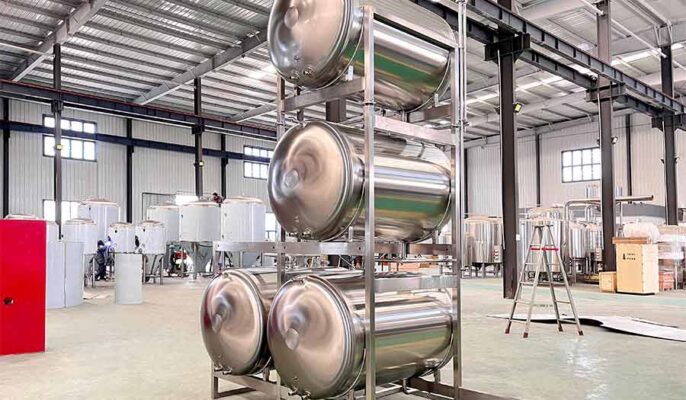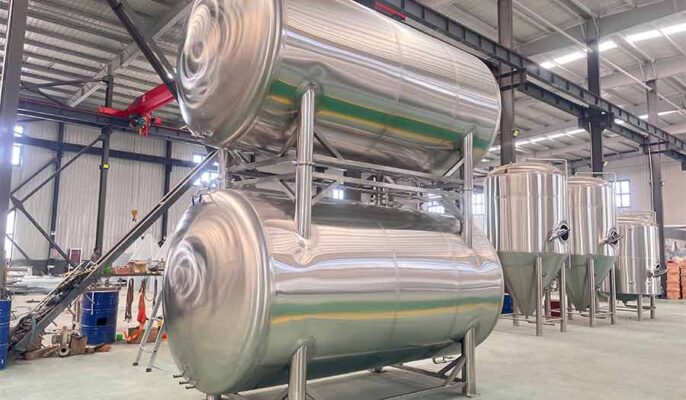Bright tanks are a key component in craft beer production and are used for the clarification and carbonation of beer and kombucha. The bright tank is the final stop in the brewing process after the beverage leaves the brewery and fermentation tanks. It also serves as a storage tank for preserving beer for testing and analysis.
What is a bright tank?
A bright tank is a stainless steel container used for carbonating and storing beer. Bright tanks are also called service tanks, bright tanks, storage tanks, or secondary fermenters. These tanks are usually pressure-rated and can be equipped with fittings that allow for safe pressure transfer. The word “Brite” in bright tanks refers to the fact that these tanks were used to store beer that had been fermented and clarified. So, beer stored in bright tanks is bright and ready to drink.
How do bright tanks work?
After the beer completes primary fermentation in the fermenter, it will be transferred to a bright tank. The beer is then cooled to the desired temperature using a cooling system within the tank. As the beer cools, unwanted particles settle to the bottom, resulting in a clearer beer. Fossil carbonation is used to introduce carbon dioxide into the beer, where it dissolves and creates the desired level of carbonation. The pressure relief valve ensures that the tank maintains a safe pressure, while the sampling valve allows the brewer to watch the progress of the beer.

Bright tank features
Clarification and carbonation
After initial fermentation, beer often contains suspended solids, yeast, and other unwanted particles. Brite tanks act as settling vessels, allowing these impurities to settle to the bottom either through natural settling or with the help of clarifiers. This clarification process produces a clearer, more appealing beer.
Carbonation, the process of injecting carbon dioxide (CO2) into beer, is another key function of a beer can. Brewers can control carbonation levels by measuring and regulating the carbon dioxide pressure inside the tank. This control ensures consistent carbonation levels from batch to batch, resulting in a pleasant mouthfeel and optimal flavor perception.
Refinement of flavor and aroma
As beer matures during fermentation, it develops a range of flavors and aromas. In sake tanks, brewers can further refine these characteristics, integrating flavors and eliminating any harshness or off-flavors. This improvement contributes to a more balanced and enjoyable beer experience.
Basic composition of a bright tank
- Tank: The tank is the main container for holding beer during the secondary fermentation process. It is usually made of stainless steel, making it both durable and stain-resistant. The tank is designed to withstand the pressure created during the carbonation process and maintain a controlled environment for the beer.
- Cooling system: To maintain the required temperature and prevent spoilage, fresh beer cans are equipped with a cooling system. The system uses refrigeration to keep the beer at the optimal temperature, preserving its flavor and extending its shelf life.
- Carbonite: Carbonite is the porous stone located at the bottom of the bright tank. Their job is to inject carbon dioxide (CO2) into the beer, carbonating it. The carbon dioxide gas diffuses through the stone in the form of small bubbles, ensuring even distribution throughout the beer.
- Pressure relief valve: To prevent excessive tank pressure, bright tanks are equipped with a pressure relief valve. The valve relieves excess pressure to maintain safe operating conditions. It is an important safety feature that protects the tank and its personnel.
- Sampling Valve: There is usually a sampling valve on bright tanks that allows the brewer to take samples for quality control and testing. The valve enables brewers to watch the beer’s clarity, flavor and carbonation levels throughout the maturation process.
Difference Between Bright Tanks and UNITANKS
Between Bright Tanks and Unitanks, you might say that Bright Tanks have a simpler design. the biggest and most immediate difference between bright tanks and combined tanks is their shape. The bright tank has a very simple flat-bottomed cylindrical design. The flat bottom is not as suitable for the fermentation process as the tapered bottom of the single tank, but the beer tank is still perfect for storing beer while it is maturing or holding the beer while waiting to be packaged.

Advantages of bright tanks
Better beer clarity
The benefits are reflected in the name of the tank. The bright tank is usually the destination for the beer after it has fermented for some time in separate tanks. Because the yeast is filtered out before being transferred to the beer tanks for aging, your final product is much clearer than beer aged with leftover yeast. Some breweries prefer this clearer quality. That’s why they chose bright tanks for the aging process.
Large production potential
For breweries that produce large quantities of beer, a bright tank may be the best choice. larger breweries ferment beer in one area and then serve or package it in another area. By using a bright tank, you can transfer the fermenting beer out of the fermenter it occupied, thereby freeing up that fermenter to receive and start another batch of beer as you serve or package from the bright tank. This means you can produce more batches in less time.
Alternatives are cheaper
the day comes when you need to replace the tanks you use for fermentation and aging. When this happens, bright tanks tend to be cheaper because they have a simpler design and only serve one function. Replacing Union tanks cost more than replacing British tanks. So if you’re on a tight budget, a bright tank may be a wiser investment in the long run.
Why are bright tanks important in brewing?
There are several reasons why bright tanks are so important in the brewing industry. One of the most important factors is that it provides the final conditioning and carbonation to the beer. This is important as it ensures the beer has the desired flavor profile and carbonation levels before it is packaged for distribution.
Another reason why a bright tank is important is that it stores beer in a hygienic and airtight environment. This is important because it helps prevent beer contamination, which can lead to beer odors and other problems. Additionally, storing beer in bright tanks helps extend its shelf life, which is important for breweries that need to distribute beer over a large area.
Finally, a bright tank is important because it allows for efficient beer production. By using bright tanks, breweries can produce large quantities of beer with consistent flavor and quality. This is important for breweries that need to cater to a large customer base.
Things to consider when buying a bright tank
A bright tank is an integral part of the brewing process. Not only do they enhance the look and taste of beer, but they also give brewers the tools to achieve consistent quality and carbonation levels. When considering purchasing bright beer cans, breweries should consider several factors. These include required tank capacity, available space, cooling system specifications, pressure and safety features, ease of cleaning and maintenance, and the manufacturer’s reputation and reliability. By evaluating these considerations, breweries can choose bright beer tanks that meet their specific requirements and long-term goals.




